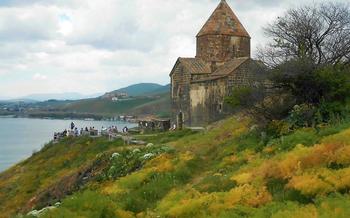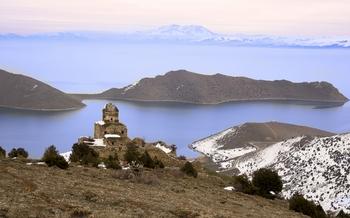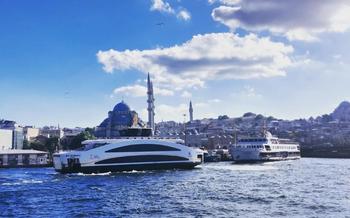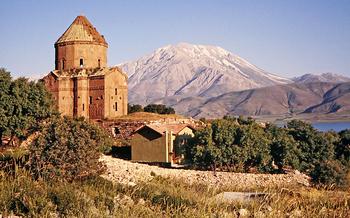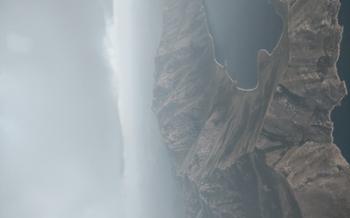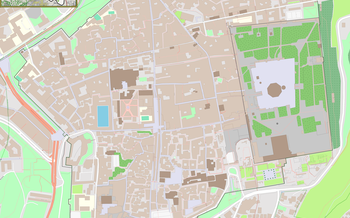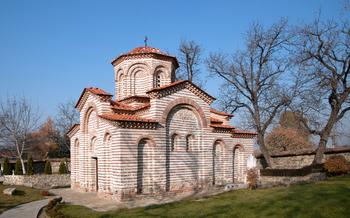
Ktuts Monastery
- Ktuts Monastery: A Historical Gem in Van
- Location and Accessibility
- Exploring the Monastery Grounds
- Delving into the History of Ktuts
- Armenian Heritage and Symbolism
- Admire the Stunning Architecture
- Pay Homage to the Church of the Holy Cross
- History and Significance
- Architectural Features and Design
- Stunning Frescoes and Artwork
- Anecdote: A Religious Ceremony
- Witness the Beauty of the Surrounding Nature
- Immerse Yourself in Local Traditions
- Interact with the Friendly Locals
- Discover Hidden Gems in the Vicinity
- Plan Your Visit: Essential Information
- Capture the Essence of Ktuts Through Photography
- Insider Tip: Unveiling the Hidden Chamber
Ktuts Monastery: A Historical Gem in Van
The Ktuts Monastery stands as a proud testament to the rich history and cultural heritage of Van, Turkey. This ancient sanctuary, nestled amidst the picturesque landscapes of the region, invites travelers to embark on a journey of exploration and discovery. Built in the 10th century, the monastery has witnessed centuries of religious devotion, political turmoil, and cultural exchange, leaving behind an enduring legacy that continues to captivate visitors today.
With its unique architectural features, intricate artwork, and profound spiritual significance, the Ktuts Monastery is a must-visit destination for anyone seeking a glimpse into the past. This hidden gem offers a serene retreat, inviting travelers to immerse themselves in the tranquility of its surroundings and connect with the deep-rooted traditions that have shaped this sacred site.
As you wander through the monastery's grounds, you'll be struck by the intricate fusion of Armenian and Byzantine architectural styles. The imposing walls, adorned with delicate carvings and colorful frescoes, tell tales of a time when faith and artistry intertwined. Each stone, each arch, and each mosaic holds a story, whispering secrets of a bygone era.
Prepare to be captivated by the tales of past inhabitants who once walked these hallowed halls, leaving behind their mark on the monastery's history. From humble monks to influential scholars, their lives and contributions have woven a rich tapestry that adds depth and meaning to the site.
It is said that within the confines of these ancient walls, a young monk named Gregory spent countless hours meticulously copying sacred texts, his unwavering devotion illuminating the scriptorium with a radiant glow. His legacy lives on in the beautifully preserved manuscripts that grace the monastery's collection, each page a testament to the enduring power of faith and the written word.
As you delve deeper into the monastery's secrets, you'll discover the Church of the Holy Cross, a sanctuary of exquisite beauty and spiritual significance. The intricate frescoes adorning its walls depict scenes from the Bible, their vibrant colors bringing to life the stories of faith, hope, and redemption. The soft glow of candlelight casts a warm and ethereal glow upon the altar, inviting visitors to pause and reflect on the sacredness of this space.
Location and Accessibility
The Ktuts Monastery is located in the village of Ktuts, situated approximately 20 kilometers northeast of the city of Van in eastern Turkey. To reach the monastery, visitors can take a scenic drive along the winding roads that lead through the picturesque countryside, enjoying the breathtaking views of the surrounding mountains and valleys. The journey offers a glimpse into the region's rich natural beauty and provides an opportunity to appreciate the tranquility and serenity of the area.
When planning a visit to the Ktuts Monastery, it is advisable to consider the best time to go. The monastery is open to visitors throughout the year, but the weather conditions can vary significantly depending on the season. The ideal time to visit is during the spring and autumn months (April-May and September-October) when the weather is generally pleasant and suitable for outdoor exploration. During these months, visitors can comfortably walk around the monastery grounds and take advantage of the beautiful surroundings.
Exploring the Monastery Grounds
The Ktuts Monastery sprawls across a vast expanse, exuding an aura of antiquity and spirituality. Its layout is a testament to the architectural prowess of its builders, with various buildings and structures arranged harmoniously within the complex.
One of the most prominent features of the monastery is its towering main church, which boasts an impressive dome that dominates the skyline. The interior of the church is adorned with intricate frescoes and artwork, depicting scenes from the Bible and the lives of saints. The walls are lined with ancient manuscripts, some of which date back centuries.
Another highlight of the monastery is its scriptorium, where monks painstakingly copied and illuminated manuscripts by hand. The scriptorium contains a wealth of historical and cultural treasures, including rare books, maps, and chronicles.
As you wander through the grounds, you'll encounter numerous other intriguing structures, such as a bell tower, a refectory, and a dormitory. Each building has its own unique history and charm, contributing to the overall tapestry of the monastery.
Anecdote:
During my visit to the monastery, I stumbled upon a hidden chamber tucked away behind a secret door. Inside, I discovered a collection of ancient artifacts that had been hidden away for centuries. Among them was a beautifully preserved manuscript that contained the writings of a long-forgotten monk. It was a thrilling moment, as if I had been granted a glimpse into the past.
Delving into the History of Ktuts
The foundation of the Ktuts Monastery dates back to the 10th century, a time when the region was under the rule of the Armenian Bagratid dynasty. It is believed that the monastery was initially established as a small hermitage by a group of Armenian monks seeking refuge from religious persecution. Over the centuries, the monastery grew in size and significance, becoming a prominent religious and cultural center in the region.
In the 13th century, the monastery was expanded and fortified, reflecting the increasing power and influence of the Armenian Church. During this period, the monastery became a refuge for Armenian refugees fleeing from the Mongol invasions. The monks of Ktuts provided shelter, food, and spiritual guidance to those who sought refuge within its walls.
Throughout its history, the monastery has been home to a diverse community of monks, scholars, and artisans. These individuals contributed to the monastery's rich cultural heritage, producing illuminated manuscripts, translating religious texts, and creating beautiful works of art. The monastery also served as a center of learning, with a renowned scriptorium where monks meticulously copied and preserved ancient texts.
In the 19th century, the monastery faced a period of decline due to political turmoil and persecution. However, in recent years, there has been a renewed interest in preserving and restoring the monastery's historical and cultural significance. The Armenian community has played a vital role in these efforts, working to restore the monastery's buildings, protect its artifacts, and promote its rich history.
Armenian Heritage and Symbolism
The Ktuts Monastery bears witness to the profound influence of Armenian heritage and culture. Its distinctive architectural elements, such as the intricate carvings and cross-shaped motifs, reflect the rich artistic traditions of the Armenian people. The symbolism embedded in the artwork and iconography throughout the monastery holds deep religious and cultural significance, offering visitors a glimpse into the spiritual beliefs and practices of the Armenian community.
One particularly captivating anecdote highlights the enduring connection between the monastery and its Armenian roots. During a visit, a local guide shared a story about a hidden chamber within the monastery that was once used as a secret meeting place for Armenian revolutionaries during times of persecution. The discovery of this hidden chamber, concealed behind a seemingly ordinary wall, serves as a reminder of the resilience and determination of the Armenian people in preserving their cultural identity amidst adversity.
Admire the Stunning Architecture
The Ktuts Monastery boasts an architectural style that is a testament to the craftsmanship of its builders. Its exterior is adorned with intricate carvings, arches, and domes, while the interior is a harmonious blend of Armenian and Byzantine influences. Take time to admire the towering walls, which feature alternating bands of red and black stone, creating a striking visual effect. Inside, the monastery's layout is centered around a courtyard, with various buildings and structures arranged around it. Don't miss the elegant arches and columns that support the galleries and balconies, adding a touch of grandeur to the space.
Anecdote: During my visit, I was particularly drawn to the intricate carvings on the capitals of the columns. Each capital featured a unique design, depicting scenes from the Bible, mythical creatures, and floral motifs. It was fascinating to see how the sculptors had managed to capture such intricate details in stone.
Pay Homage to the Church of the Holy Cross
Amongst the many architectural wonders that grace the grounds of the Ktuts Monastery, the Church of the Holy Cross stands as a testament to the enduring faith and artistry of its builders. Constructed in the 10th century, this sacred edifice has borne witness to centuries of worship, prayer, and contemplation.
History and Significance
The Church of the Holy Cross holds a profound historical significance within the Armenian Christian community. It is believed to have been built on the site of an earlier church, dating back to the 4th century, which was destroyed during the tumultuous period of Byzantine rule. The current structure was erected under the patronage of King Gagik I Artsruni, a devout Christian who sought to revitalize the Armenian Apostolic Church in the region.
Architectural Features and Design
The Church of the Holy Cross is a remarkable example of medieval Armenian architecture. Its exterior façade is adorned with intricate carvings and bas-reliefs, depicting biblical scenes and symbolic motifs. The interior of the church is equally impressive, with its soaring arches, vaulted ceilings, and exquisitely painted frescoes. The walls are adorned with vibrant murals depicting the life of Jesus Christ, the Virgin Mary, and various saints, creating a sense of awe and reverence within the sacred space.
Stunning Frescoes and Artwork
One of the most striking features of the Church of the Holy Cross is its collection of stunning frescoes. These vibrant and well-preserved paintings cover the walls and ceilings of the church, narrating biblical stories and depicting scenes from the lives of saints and martyrs. The frescoes are a testament to the artistic prowess of the medieval Armenian masters who created them, and they continue to captivate visitors with their beauty and expressiveness.
Anecdote: A Religious Ceremony
During my visit to the Church of the Holy Cross, I had the privilege of witnessing a traditional Armenian religious ceremony. The church was filled with the melodious sounds of hymns and prayers, as the faithful gathered to celebrate their faith. The atmosphere was one of deep devotion and spirituality, and I felt a sense of awe and wonder as I observed the ancient rituals unfolding before my eyes.
Witness the Beauty of the Surrounding Nature
The Ktuts Monastery is not just a historical and cultural treasure; it is also a place of unparalleled natural beauty. Perched on a hilltop, the monastery offers breathtaking views of the surrounding landscape. On a clear day, you can see for miles in every direction. The monastery is surrounded by lush forests, rolling hills, and sparkling rivers. The air is fresh and clean, and the sounds of nature are all around you.
If you're lucky, you might even catch a glimpse of some of the local wildlife. The area is home to a variety of animals, including bears, wolves, deer, and eagles. You can also see a variety of wildflowers and plants, many of which are unique to the region.
For nature lovers, the Ktuts Monastery is a true paradise. There are plenty of opportunities for hiking, biking, and birdwatching. You can also simply relax and enjoy the peace and tranquility of the surroundings.
Anecdote:
On my last visit to the Ktuts Monastery, I was lucky enough to witness a breathtaking sunset. The sky was painted with vibrant colors of orange, red, and purple. The sun slowly sank below the horizon, casting a warm glow over the monastery and the surrounding landscape. It was a truly magical moment, and I felt incredibly fortunate to be there to experience it.
Immerse Yourself in Local Traditions
The region surrounding the Ktuts Monastery is a treasure trove of cultural practices and traditions that have been passed down through generations. Visitors can delve into the vibrant local lifestyle by engaging with the friendly locals and immersing themselves in their customs. Traditional crafts and handicrafts, such as intricate carpets, ornate pottery, and delicate embroidery, showcase the region's rich artistic heritage. Local cuisine is a delightful blend of flavors, with dishes like freshly baked bread, savory kebabs, and delectable desserts tantalizing the taste buds.
One unforgettable experience is participating in the traditional dance called "halay." This lively dance involves forming a circle and holding hands while moving in unison to the rhythm of traditional music. It's a joyous celebration that brings people together and allows visitors to connect with the local culture on a deeper level.
Interact with the Friendly Locals
The people of Van are renowned for their warm hospitality and welcoming nature. They take pride in sharing their culture and traditions with visitors, creating a welcoming atmosphere that makes you feel at home. Don't hesitate to strike up a conversation with the locals, who are always eager to share stories about their lives, customs, and the region's history.
One memorable interaction I had was with an elderly woman named Ayşe, whom I met while visiting a local market. She invited me to join her for tea and insisted on showing me around the market, introducing me to local delicacies and explaining their significance. Her warmth and kindness left a lasting impression, and I felt a genuine connection to the local community.
Attending local festivals and events is another fantastic way to immerse yourself in the vibrant culture of Van. These celebrations showcase traditional music, dance, and cuisine, providing a glimpse into the region's rich heritage. Don't miss the annual Van Festival, where you can witness colorful processions, traditional sports competitions, and lively performances that will leave you captivated.
Discover Hidden Gems in the Vicinity
As you venture beyond the monastery walls, a wealth of hidden gems awaits discovery. Quaint villages nestled amidst rolling hills beckon with their rustic charm and rich cultural traditions. Immerse yourself in the daily rhythms of local life, where traditional crafts and handicrafts are still lovingly preserved. Engage with the villagers and learn about their unique customs, passed down through generations.
Venture further to uncover lesser-known historical sites that whisper tales of the region's storied past. Explore ancient ruins, abandoned churches, and forgotten fortresses, each holding its own secrets and mysteries. Let your curiosity guide you as you piece together the fragments of history that have been left behind.
Nature, too, has its wonders to reveal in the vicinity of Ktuts Monastery. Discover hidden waterfalls cascading down rocky cliffs, lush forests teeming with diverse flora and fauna, and secluded mountain trails that lead to breathtaking viewpoints. Whether you prefer a leisurely stroll or an invigorating hike, the surrounding landscapes offer endless opportunities for exploration and adventure.
Anecdote:
During my exploration of the monastery's surroundings, I stumbled upon a hidden gem that left me in awe. Nestled in a secluded valley, I discovered an ancient cave adorned with intricate carvings and paintings. The cave seemed to hold the whispers of time, as if the spirits of the past still lingered within its walls. It was a moment of pure wonder and discovery, reminding me of the countless hidden treasures that await those who dare to venture off the beaten path.
Plan Your Visit: Essential Information
Before embarking on your journey to the Ktuts Monastery, it is essential to plan your visit wisely to make the most of your experience. Here are some crucial details to keep in mind:
- Opening Hours and Admission Fees:
The Ktuts Monastery is open to visitors from 9 am to 5 pm daily, except on Mondays when it is closed. Admission fees are minimal, providing an affordable opportunity to explore the monastery's treasures.
- Guided Tours and Availability:
Guided tours are available for those seeking a deeper understanding of the monastery's history and significance. Tours are offered in multiple languages and can be arranged in advance or upon arrival, subject to availability.
- Facilities and Amenities for Visitors:
The monastery provides basic facilities for visitors, including restrooms, a small cafeteria, and a souvenir shop. While there are no restaurants within the monastery grounds, visitors can find dining options in the nearby town of Van.
- Practical Tips for a Smooth Visit:
To ensure a smooth and enjoyable visit, consider these practical tips:
- Wear comfortable shoes, as the monastery involves a fair amount of walking.
- Dress respectfully, as the monastery is a religious site.
- Bring a camera to capture the stunning beauty of the monastery and its surroundings.
- Allow ample time to explore the monastery, as there is much to see and discover.
Capture the Essence of Ktuts Through Photography
The Ktuts Monastery offers a wealth of photographic opportunities, inviting visitors to capture its beauty and essence through the lens. To make the most of your photography experience, here are some tips:
-
Harness the Golden Light: Arrive early in the morning or late in the afternoon to capture the monastery bathed in soft, golden light, which enhances the intricate details of its architecture and creates a magical atmosphere.
-
Explore Different Angles: Don't limit yourself to frontal shots. Explore the monastery from various angles to capture its grandeur and unique perspectives. Experiment with different vantage points to create dynamic compositions.
-
Focus on Details: While the overall monastery is impressive, don't overlook the intricate details that add character and charm. Capture close-ups of carvings, frescoes, and other decorative elements to showcase the craftsmanship and artistry that went into its construction.
-
Embrace Reflections: Utilize the reflective surfaces of the nearby water bodies to create stunning compositions. The reflections add depth and symmetry to your shots, especially during sunrise and sunset.
-
Capture the Spirit of the Place: Beyond the physical beauty of the monastery, try to capture the essence and spirit of the place. Photograph monks engaged in their daily rituals, visitors exploring the grounds, or pilgrims seeking solace and reflection.
Insider Tip: Unveiling the Hidden Chamber
As you explore the depths of the Ktuts Monastery, keep an eye out for a hidden chamber concealed within its walls. This secret room holds immense historical significance, once serving as a sanctuary for monks seeking refuge during times of persecution.
To access this hidden chamber, you must venture off the beaten path and follow a concealed passageway. Once inside, you'll be greeted by a dimly lit room adorned with ancient frescoes and cryptic inscriptions. The atmosphere is palpable, transporting you back in time to a period shrouded in mystery and intrigue.
Discovering this hidden chamber is like stumbling upon a long-lost treasure. It's a testament to the rich history and resilience of the Ktuts Monastery, inviting you to unravel its secrets and connect with its past.

